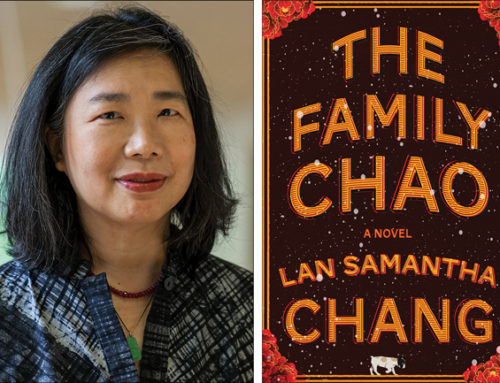Assistant Poetry Director Iris Dunkle interviewed poet Kazim Ali for the journal Chautauqua in 2012. In the excerpt below, they discuss history, place and their intersection.
You may read the full interview in PDF format or visit the journal Web site for further info.
Note: Kazim Ali and I met at the Crooker Art Museum in Sacramento, CA on June 22, 2012. In between yoga sessions and a benefit reading for the Squaw Valley Writer’s Conference, Kazim found time to sit down and reflect on some of the many journeys and pilgrimages he has ventured on during his lifetime.
Kazim Ali was born in the UK to Muslim parents of South Asian and Middle Eastern descent. His books include four volumes of poetry, The Far Mosque, The Fortieth Day, the mixed genre Bright Felon: Autobiography and Cities and Sky Ward. He has also published two novels, Quinn’s Passage and The Disappearance of Seth; two collections of essays, Orange Alert: Essays on Poetry, Art and the Architecture of Silence and Fasting for Ramadan: Notes from a Spiritual Practice; as well as translations of poetry by Sohrab Sepehri and a novel by Marguerite Duras. Recently he edited the essay collection Jean Valentine: This-World Company. In addition to being associate professor of Creative Writing and Comparative Literature at Oberlin College and founding editor of Nightboat Books, he is a certified Jivamukti Yoga instructor.
[…]
You have so many incredible reoccurring images in Bright Felon. Your ability to interweave and resurface images, along with your cross-genre writing reminds me of h.d.’s haunting work Notes on Thought and Vision. Your work, like h.d.’s, brings up the reoccurring image of islands and the idea that history rises up and seeps into our present day experiences. Can you talk a little about what these reoccurring images and their relationship to the past mean?
On first read, Bright Felon seems diffuse and random. But many parts of it have a secret architecture. The middle of the book is like a little envelope: the chapters are titled “New York City,” “Paris,” “Corsica,” “Paris,” “New York City” because I traveled to these cities in this order. But it is significant that the island of Corsica is at the center of this progression. I was interested in it not just as an island but also for its geographic significance. If you look at a topography map which includes the oceans, you can see that Corsica is the end of the Alps. The Alps roll down to the edge of the sea and they keep going — you don’t see because there is water there — but they keep going under the water and then they come out at Corsica. Sardinia is the top of the other range from Africa that’s coming up, so they sort of meet each other in Corsica and Sardinia. One place I didn’t go in Corsica is a small town at its very southern tip — there is a little town that faces another small town in Sardinia just across this expanse of water. Maybe someday when I go back on a Bright Felon reunion tour I can visit it.
I really liked that idea of our lives — ourselves — having submerged elements. Have you ever had the experience where you can remember a feeling but you don’t remember what the feeling was associated with? You are on a street corner and suddenly feel an intense feeling of happiness and you don’t know why you are feeling it. Maybe later you’ll remember; you’ll remember the actual narrative details about it: that this was the street corner where you came out of an incredible movie or had dinner with an old friend. But the feeling is real even if you don’t remember the narrative that accompanies it. Our lives are like this: we have all of these experiences that are submerged in us that come out and then sink back under the surface as we live our lives. It’s one of the reasons why it’s important for us to live in the moment and behave out of our immediate circumstances instead of basing responses on memories of past actions because those past actions aren’t even real anymore even though they still exert a pull on us.
I became really interested in this phenomenon in Bright Felon because that entire book is about a tendency to remain silent.
[…]
When I was living in Oil City, I became obsessed with the history of the place. There was a small oil boom town nearby called Pithole and I spent a year reading and writing about its history. Part of the reason why I become obsessed with its history was because I was living in a place that was completely isolating. The digging up of history — learning and questioning it — gave me a way to not only understand the place in which I was living but also myself as I was living in it. Based on some of the chapters in Bright Felon it sounds like you had a similar experience in places like Carlisle. Can you talk a little about your experience writing this chapter?
Carlisle is a really good example of a city built on top of a city — a place where the history of the place rises up to meet its present. There is history that has happened in a place and that history isn’t linear. It’s happening all at once, so the physical karma of a place is more obvious. In Carlisle, what I talk about in Bright Felon is the slave cemetery that was plowed over and made into a park. This is historical or psychic karma of the people who once lived in a place. What happened there left an energy. Marianne Moore lived in Carlisle, the University is there, the Carlisle Indian School was there, and it manifests itself physically. Physicists have proven that time and space bend; we don’t understand the mystical aspects of history and how it is connected to the physical. When you go to a place where a massacre occurred, these places maintain their power. That’s why the train tracks near Auschwitz contain power. That’s why sacred places like the Western Wall or the Church of the Holy Sepulcher in Jerusalem, where I was last summer, are so intense because of what may or may not have happened there and because of the people who go there seeking reunion with that place.
So, Carlisle is a very complicated place because it contains complicated historical sites such as the Indian School, which had a brutal re-education program. Native American children were sent there, to have their hair and their culture “groomed” out of them, until their connection to their culture and language was lost. At the same time, you also have the great treaty that was signed there (and quickly broken) between the citizens of the new city of Carlisle and the Native Americans. The town was founded with this intent that this will be the frontier, but we will slowly build out to control the pass. It’s a very powerful place and the people who live there know it. To me that historical complexity and power was in the air. One can feel history in that way. One of the reasons why I love Susan Howe’s writing so much is because of the way she experiences history in this way. She has this ability to see ghosts in a place — like in her poem “Thorow” in Singularities. I think American readers don’t like to have this type of relationship with place. They want to have a level of amnesia with place and the reason for that is because such a violence was perpetuated against the original possessors of the land that an erasure had to occur. In many places, it is an ironic erasure because so many of the names are the same. In New York, you have the towns of Onondaga and Onieda — places that are named after the absent people. The Oneida people now live in Wisconsin, but their name remains also in New York. Historical erasure has taken a number of different forms in America, but almost always it includes a physical inscribing on the landscape of the new. For example, Mount Rushmore in South Dakota wasn’t merely carved on any mountain. It was carved on a mountain that was sacred to the Dakota people. The mountain was called the Six Grandfathers because it had six different crags. When construction for Mt. Rushmore began, two of the crags were dynamited off and the remaining crags became the four presidents that were carved onto them. This was an intentional, strategic writing of American history onto the sacred stone of the Lakota people. In the Lakota language the word for stone and mountain are the same word and the word for grandfather is derived from that word.
And that’s how you do it, that’s how you erase history.
And that’s why we get to dig it up and write about it.
Yes, that’s why we have to!
[…]
Can you talk about the confluence that occurs in the poem, “Home”? There’s your personal experience, the beautiful story of the blanket, memory and the present and it all seems to come together in the moment of the poem. How did you bring this all together in this spectacular poem?
When I remember lines from this book, they come from this chapter. For me, this chapter is the heart of the book. “God’s true language is only silence and breath . . . I want to be those stairs, the hunger I felt, the river inside.”
Home is the home source. It is the earliest part of our lives, but home is also our source. For me, I want my home to be my life wherever I am. I want to be at home with the people of my life, and the places of my life so that it doesn’t matter where I am, I will be at home. Whether I’m at my house in Oberlin, OH, or at a museum in Sacramento, CA, I am will be at home. When I look out the window here at the museum, I am reminded of places I’ve been in Paris, Jerusalem, or Mumbai because I’ve been in places like this: museums, coffee shops, yoga studios. These places make wherever I am home for me. A place becomes sacred because a person is there, because you are there. Home is a confluence. “You should travel so much that you become a stranger in your own land,” Nerval said. Or he said something very like that. But I want to do the opposite of what this quote subscribes. I want to travel so much that everywhere I go becomes my home. That nowhere am I a stranger and nothing is strange. I want my body to be my home. Your body is a beautiful part of you that should be worshiped, preserved and celebrated. If we just knew our bodies, we would be utterly incapable of selfishness, greed and committing violence against other people. That’s what I dream about.
Watch our Public Readings & Lectures page and mark your calendars to join us to hear Kazim during conference week, July 27 – August 1.







